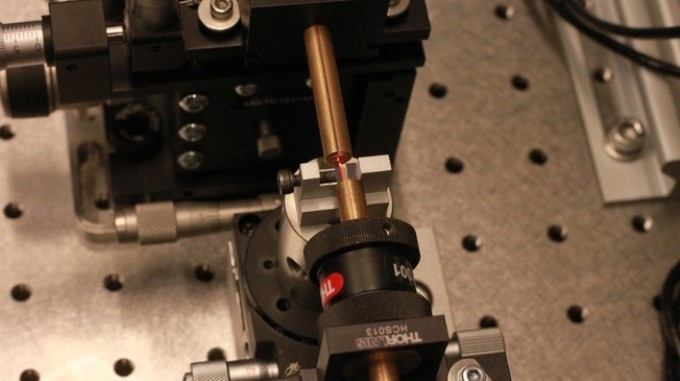Oct 26 2017
In electronic devices, the performance of a chip is limited by electron speed and by overheating produced by the electric current during intensive use. In order to overcome this problem, a many research projects try to combine both optical and electronic components on one chip or to generate all-optical chips.
The ultimate aim of the researchers is to make the chips faster, use less energy, and reduce overheating. However, to attain all that, they will have to integrate a number of nonlinear optical functions without undermining the performance of the chips.
 CREDIT: 2017 PHOSL.
CREDIT: 2017 PHOSL.
Innovative optical functions have been integrated into a single chip compatible with CMOS fabrication a research from the EPFL’s Photonic Systems Laboratory. The team was headed by Camille Brès, working with Tobias Kippenberg’s Laboratory of Photonics and Quantum Measurements. They achieved it by using light— without using electrodes. The study has been reported in the journal Nature Communications. Possible uses of this technology are stabilization of frequency combs, data detection and processing for fiber optics, and on-chip quantum optics.
Artificially inducing nonlinear phenomena
Light can be used as a fascinating substitute to electric current for specific applications in spectroscopy as well as telecommunications and sensing. In order to transmit and receive data, and for investigating chemical compounds, light has to be regulated, transformed, and used in a guiding material that has nonlinear characteristics. In fact, majority of the optical tasks mandate the use of materials that give rise to nonlinear (i.e. second-order) effects. Upon interacting with light, these materials can, for instance, double the energy, and consequently the frequency, of photons. This technique, known as second harmonic generation, is pivotal for various applications.
The only complication arises due to silicon and its compounds that are used in majority of the traditional CMOS-compatible electronic chips. Owing to its centro-symmetry, silicon does not manifest such second order nonlinearity. Other materials that do exhibit the second order nonlinearity cannot be integrated onto the chips easily.
Camille Brès and her colleagues discovered a method to overcome this drawback. They were successful in bringing about the desired result of nonlinearity in silicon-nitride-based waveguides, devising the second harmonic nearly 1000 times more efficacious.
“We used a laser to excite electronic transitions in the silicon nitride. We basically broke the material’s symmetry,” stated Brès. “Once the laser is injected, the modification remains inside the waveguide, which therefore contains the nonlinearity that we are looking for. We can also change the periodicity of this nonlinearity at will, so that second harmonic generation can take place over a wide range of frequencies without us having to modify the chip itself,”
Davide Grassani, co-author of the article.
To date, researchers could only disturb the symmetry of the atoms by adding electrodes to the waveguide or by pressurizing it, which makes fabrication of the chips difficult and leaves the waveguide modified forever. The innovative process devised by the team is simple and enables developing a highly modifiable waveguide. One more unique benefit of this process is the application of silicon nitride—the material usually used in the electronics industry and well-adaptable to prevalent CMOS technologies.